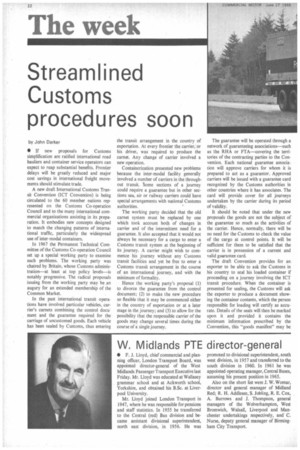Streamlined Customs procedures soon
Page 24

Page 25

If you've noticed an error in this article please click here to report it so we can fix it.
by John Darker • If new proposals for Customs simplification are ratified international road hauliers and container service operators can expect to reap substantial benefits. Frontier delays will be greatly reduced and major cost savings in international freight movements should stimulate trade.
A new draft International Customs Transit Convention (ICT Convention) is being circulated to the 60 member nations represented on the Customs Co-operation Council and to the many international commercial organizations assisting in its preparation. It embodies new concepts designed to match the changing patterns of international traffic, particularly the widespread use of inter-modal containers.
In 1967 the Permanent Technical Cornmittee of the Customs Co-operation Council set up a special working party to examine such problems. The working party was chaired by Britain, whose Customs administration—at least at top policy levels—is notably progressive. The radical proposals issuing from the working party may be an augury for an extended membership of the Common Market.
In the past international transit operations have involved particular vehicles, carrier's carnets combining the control docu ment and the guarantee required for the carriage of uncustomed goods. Each vehicle has been sealed by Customs, thus entering the transit arrangement in the country of exportation. At every frontier the carrier, or his driver, was required to produce the carnet. Any change of carrier involved a new operation.
Containerization presented new problems because the inter-modal facility generally involved a number of carriers in the throughout transit. some sections of a journey could require a guarantee but in other sections sea, air or railway carriers could have special arrangements with national Customs authorities.
The working party decided that the old carnet system must be replaced by one which took account both of changes in carrier and of the intermittent need for a guarantee. It also accepted that it would not always be necessary for a cargo to enter a Customs transit system at the beginning of its journey. A carrier might wish to commence his journey without any Customs transit facilities and yet be free to enter a Customs transit arrangement in the course of an international journey, and with the minimum of formality.
Hence the working party's proposal (1) to divorce the guarantee from the control document; (2) to make the new procedure so flexible that it may be commenced either in the country of exportation or at a later stage in the journey; and (3) to allow for the possibility that the responsible carrier of the goods may change several times during the course of a single journey. The guarantee will be operated through a network of guaranteeing associations—such as the RHA or FTA—covering the territories of the contracting parties to the Convention. Each national guarantee association will approve carriers for whom it is prepared to act as a guarantor. Approved carriers will be issued with a guarantee card recognized by the Customs authorities in other countries where it has associates. The card will provide cover for all journeys undertaken by the carrier during its period of validity.
It should be noted that under the new proposals the goods are not the subject of the guarantee so much as the activities of the carrier. Hence, normally, there will be no need for the Customs to check the value of the cargo at control points. It will be sufficient for them to be satisfied that the carrier is in possession of a current and valid guarantee card.
The draft Convention provides for an exporter to be able to ask the Customs in his country to seal his loaded container if proceeding on a journey involving the ICT transit procedure. When the container is presented for sealing, the Customs will ask the exporter to produce a document showing the container contents, which the person responsible for loading will certify as accurate. Details of the seals will then be marked upon it and provided it contains the minimum information prescribed by the Convention, this "goods manifest" may be the normal commercial document.
Whenever a container—.or vehicle— enters the transit procedure, the carrier will complete a simple declaration and attach it to the goods manifest bearing the details of the seals. The carrier will produce his guarantee card for any section of the journey for which he is responsible, when necessary.
At frontier points a master copy of the declaration will be produced by the carrier, and whenever a container or vehicle is handed over to a new carrier this master copy will also be handed over. At each frontier a copy of the declaration will be deposited with the customs. '
Because the Convention is not limited to containers alone and will be available to all other means of transport—including inland waterway vessels—the Convention does not distinguish between transport media, the term "transport unit" being used to cover all means of transport conforming to the agreed international standards of Customs security for sealing purposes.
Further simplifications are expected to be introduced if the Convention is ratified. There is provision in the scheme for groups of countries to join together to form.regions (ICT areas). Goods passing through these regions will be subject to controls at entry or exit frontiers only, with no check at intermediate frontiers.
Close collaboration has been maintained by the working party of the Customs Cooperation Council and the Economic Commission for Europe which also has a working party studying Customs questions affecting transport. Because of the weight of commercial interests in favour of the new simplified Customs procedures the chances of the Convention being signed in June 1970 are believed to be good. The Common Market countries, Scandinavia, the United States, Japan and Australia are members of the Customs Co-operation Council, although the USSR is not.


















































































































